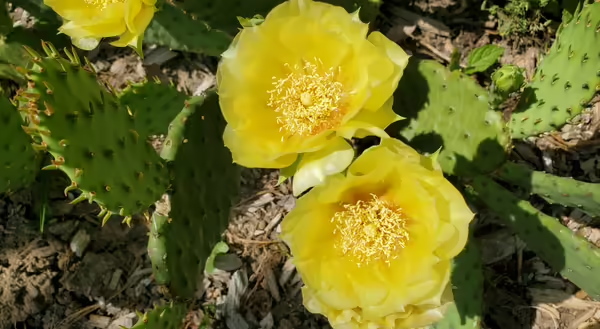
I am always amazed at the diversity of native species our state hosts from top to bottom. All in all, Illinois spans three USDA cold hardiness zones which illustrates the difference in climate from our northern counties to the southern confluence of the Ohio and Mississippi rivers. In total, around 2,500 plant species are native to the Land of Lincoln and among their ranks are some truly interesting standouts that can seem like surprising examples of a native species to Illinois or even the Midwest.
Once such standout is in full bloom across central Illinois this week. The yellow flowers of our native eastern prickly pear cactus (Opuntia humifusa) are lighting up stands of cacti while attracting crowds of native pollinators.
A surprising Illinois native
Its utterly amazing to most folks to learn we have a native cactus in Illinois. However, the eastern prickly pear is one of three native species of prickly pear cactus in Illinois, although the other two species (O. fragilis and O. macrorhiza) are much scarcer around the state.
Prickly pear is by far the most commonly occurring cacti, popping up in almost half of the counties in Illinois. Its scattered distribution ranges from some of the southernmost counties to the Wisconsin border and beyond. This plant is hardy from Zone 4 to Zone 9, which represents a large range from Canada to Texas and Florida.
Given its tolerance of Zone 4, the plant is quite cold hardy and easily handles our midwestern winters, while withstanding temperatures as low as -25°F at its northern extent. During winter the pads of prickly pear cactus look almost dead as they shrivel up to conserve moisture during the cold, dry winter months.
In spring, there is an explosion of growth as the pads quickly swell, produce new growth and flowering, all in the span of a little over a month. I’ve always enjoyed watching this plant “wake up” in spring as it goes through such rapid change so quickly, from lying along the ground looking dead to upright and sporting showy flowers.
Each flower is a spectacular bright yellow, which nicely contracts with the vibrant green backdrop provided by the rest of the plant. The blooms are diurnal, meaning they only last a single day, although they offer ample pollen and nectar for pollinating insects.
Prickly Pollination
Yesterday I was observing several species of both long and short tongued bees swarming the wide-open prickly pear flowers around mid-afternoon. At the center of each flower is a mass of pollen-producing anthers which stretch upward to conceal the nectaries below. The anthers have a special adaptation to ensure pollen distribution, which is activated as they are contacted by the busy bees.
This adaptation is referred to as a thigmotactic reaction, meaning it’s a reaction to sensory stimulus of some kind, such as a bee brushing by an anther. In this case, the thigmotactic anthers curl downward as they are stimulated by the bees. Since nectaries are near the bottom of the flower, the downward-turning of anthers follow nectar-seeking pollinators into the flower.
Anther moment happens quickly enough it is observable with the naked eye. They can even be stimulated to move with the touch of a finger, although care must be taken to avoid contact with the tiny, sharp bristles that abound the pads below. It’s a memorizing interaction to watch as the smaller bees dive into the tuft of anthers and almost disappear entirely as the flower structures curl down around them. In a few moments they reappear out of the depths of the flower to buzz on to the next.
Eastern prickly pear cactus has a high value for pollinators, attracting a wide range of bees over its 3-4-week bloom period. It also serves as a host plant for several moth caterpillars and some fly larvae. In addition, it supports several species of stink bug, which suck the juices from the pads and fruit. All this insect activity is truly amazing for a species that seems so foreign to our state.
As an added bit of wonder, eastern prickly pear is easily grown in cultivated garden spaces and many native plant nurseries sell pads or seeds. It readily roots from severed pads, much the same as most succulents reproduce vegetatively. If you know someone with a patch of these cacti, simply pluck off a pad, allow it callus over for a few days and place it in a well-drained garden soil.
While prickly pear appreciates sandy, rocky soil, it’s tolerant of more mesic, loam or clay-loam soils. Just be sure to use some gloves and tongs to handle the pads. It is a cactus after all!